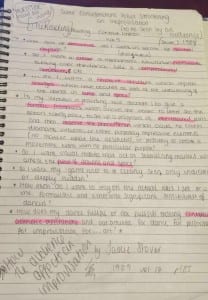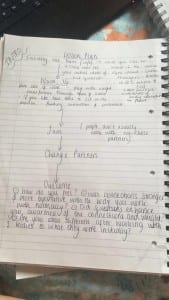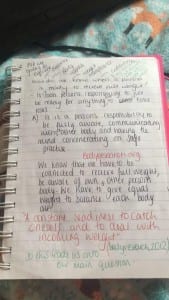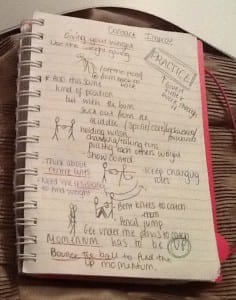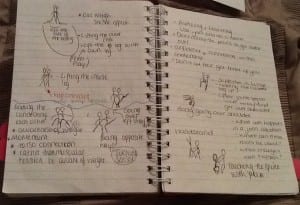ASSESSMENT
I initiated explorations with Charlie at the start of class, feeling internal sensations, and using our limbs find new ways to influence movement but with all body parts, including the head. I was aware of Charlie’s injury as she was unable to weight exchange, however I was experimenting with new ways of moving, playing with dynamics and pauses. I enjoyed the experience of internal sensations with limited movement it gave me restrictions.
I made connections with every-body in the space during our last session, I created relationships and addressed injuries as there were many people that had. I was constantly listening to the bodies I moved with, in communication through the movements.
I did focus on a quote from Caught Falling by Nancy Stark Smith, ‘complementary sensation of support coming up from the mass of earth’ (Smith Stark, N, 2008) I took this quote towards my practise for the assessment I negotiated with bodies finding this sensation of support and experienced this with the outcome of play.
Main relationships I made were with:
Jess P- She focusses hugely on the floor. I was trying to enforce risk and interesting explorations. So, I attempted to inform initiations to move more creatively. I found that when I was dancing with Jess she stopped and then adjusted herself in restart mode, and I found this difficult to continue the relationship, as we broke connections. Very habitual movements were used with the tools we had learnt from previous weeks.
Georgia- Both of us were the over and under dancers. We made internal connections with the centre of gravity, the spine and core, using twists and spirals to influence something exciting. Myself and Georgia was dancing minimally and were joined by Hannah and Chloe, where we linked to form a quartet rolling over each body and changed partners which was interesting and unexpected.
(Picked out of the hat activity) Courtney and I were the first two to enter the space I encouraged high energy and momentum to enforce connections and engagement to one another, this worked well. We made some lovely work and I felt positive about our experience as myself and Courtney have worked together in previous weeks but to a slow pace, so I wanted to attempt new movement within each other. The playfulness of our relationship gave more in-depth experiments, I feel that ‘play’ is a big part of discoveries with contact improvisation, I feel that you have to let go and go with it, allowing the bodies to experiment for themselves than thinking to much of where it will go. It gives me adrenaline for the unknown.
Kye- Myself and Kye have formed a real connection during our time of learning contact improvisation. I feel comfortable and can trust him. I feel that we are working towards the same goals, of striving for explorations with the use of learnt tools but how we can take them to new formations and findings. I engage my mind to think of findings, attempting observations I have seen from videos by professionals. Myself and Kye work incredibly well together, I have found that he brought my confidence out in this module. How we work together has influenced further developments and now I take so many risks, and I’m not scared of falling. I find that falls are inevitable, so when they happen it informs new creativity for what can come, where can we go with it, using continuity of flow at all times, connecting with one another always. We have always been aware of each other’s bodies, engaging safe practise throughout. I feel that we have helped each other connect with the practise feeding the energy we both have to the practise, using the excitement of explorations to exceed our discoveries so more happen continuously. I feel that we have both found ourselves through the extraordinary art form of contact improvisation. I now LOVE it, I look forward to new adventures with the practise.
I have learnt so much over the period of the semester, I admire everyone’s support to each other throughout the process, I found it difficult in the beginning however I through myself into it and absolutely loved it. I have never induced myself into something so creative and enjoyed it as much as I have. I have learnt so much from myself but other bodies also.
I have found myself fully connect and I’m intrigued for future developments. My career has enhanced throughout the semester engaging my awareness to a mindful body approach. I have adjusted thoughts to the idea of phenomenological approaches and how I encounter this through dance movement. I would love to undertake further contact improvisation Jams in the near future, I feel that it is so helpful for the body but also the mind. The interactions which are made make me feel so positive, yes things go wrong, but it is how I find myself exploring the ‘going wrong’ how can we delve deeper.
Adhering to the learning outcomes of the module; dancing with a variety of bodies and safe weight transference, how to give full weight and how to receive it. I have fully expressed my bodies full motion and given my upmost energy and passion to enforce and engage within creative tasks.
I appreciate the process I have been on and will only progress with the practise in more positive variations.
Caught Falling, The Confluence of Contact Improvisation, Nancy Stark Smith, and Other Moving Ideas page 90 onwards

